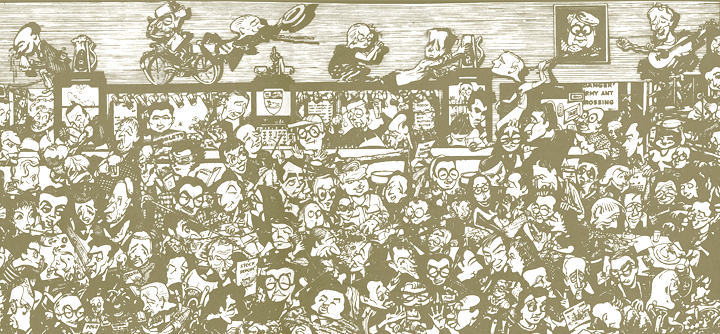
Alumni of the ’50s may recall faces in this composite caricature of Jimmy's, drawn from life by the late Art Costello, which has hung in the bar since it was created in 1955.
The history of Hyde Park’s well-loved watering hole.
One of the enduring—and endearing—qualities of the denizens of the Midway over the years has been a tendency toward being somewhat disputatious—in a friendly way, usually. This tendency carries over to the students’ home-away-from-home, the Woodlawn Tap (more frequently known as Jimmy’s), where for more than three decades people have gathered to settle the world's weighty issues over a few beers.
The carryover nature of the urge to debate was reflected this year in the nationally distributed pages of The Alternative. In successive issues appeared a nostalgic appraisal of Jimmy’s by Martin Northway (X’70), a Chicago writer, and a letter contradicting some of Mr. Northway’s assertions, written by Karl Zimmer (AB’50), an Indianapolis paper manufacturer.
[[{"type":"media","view_mode":"media_original","fid":"1317","attributes":{"alt":"","class":"media-image","height":"619","typeof":"foaf:Image","width":"460"}}]] Wilson sits at the bar. (Photography by Don Newman/Chicago Maroon, University of Chicago Photographic Archive, apf7-01596-001, Special Collections Research Center, University of Chicago Library)
Further evidence of its conversation-generating proclivities is found in the Tap itself. Unlike most such places of refreshment, it maintains a small reference library, which includes the Encyclopaedia Britannica, an English and a Latin dictionary, Bartlett’s Familiar Quotations, Shakespeare’s complete works, a Bible, and Norton’s anthology of poetry. There used to be an atlas, but, despite its bulk, someone spirited it away. (The establishment also maintains a dozen chess sets, half a dozen sets of dominoes and a couple of Go games, a bunch of softballs and other recreational paraphernalia.)
Alumni whose student days predate 1940 won't remember Jimmy, who, after eight years as a bartender at the old University Tap (its building now dismantled and replaced by a dormitory), opened the Woodlawn Tap a block east. For people of these earlier vintages, the refreshment centers included, at various times, Mike Hanley’s (like 55th Street’s other spas, now gone, as a result of urban renewal) and the Beehive, where Jimmy Yancey once played the piano. There used to be, in fact, thirty-eight taverns along the street; now there is one.
And Jimmy’s has changed over the years, along with every thing else in Hyde Park. It has had, at various times, one, two and (as at present) three rooms. Until 1967 University identification was required for admission to the West Room. In 1950 the jukebox was removed and the musical component became classical hi-fi. Came the days of the Beatles; classical music was relegated to the West Room; rock and its ramifications took over in the East Room.
[[{"type":"media","view_mode":"media_original","fid":"1318","attributes":{"alt":"","class":"media-image","height":"277","typeof":"foaf:Image","width":"460"}}]] Wilson in the front of the Woodlawn Tap. (Photography by Ben Howe/Chicago Maroon, University of Chicago Photographic Archive, apf7-01595-002, Special Collections Research Center, University of Chicago Library)
James Wilson, who has now been pouring beverages for members of the Midway community for thirty-five years, is a Chicagoan whose family is celebrating a century in the paint and hardware business. He looks back on those thirty-five years with a quizzically sentimental eye. Now 63, he says that, except for their dress and their tastes in music, he has seen little change in Chicago students over the years. And he has known thousands. (More than 300 have tended bar for him at one time or another.)
“The student hasn't changed,” he says. “The student at Chicago is just as intellectual as ever, and far more mature than most college students.”
Jimmy likes the students; that’s why he is still in business—and he still works seven days a week. He has survived a battle with Anheuser Busch (over prices; he stopped selling Budweiser a quarter of a century ago, and is now one of Schlitz’s important outlets), and a license hassle which he won after five months. (Approximately 75% of his dollar volume is beer—which means a considerably larger share of his gallonage. And in addition to the draft Schlitz [55 cents a stein] he stocks sixteen foreign beers.)
The Woodlawn Tap boasts (in addition to a West Room and an East Room) another parallel to notable historic landmarks marks and treasures: a cracked bell. One year his crew acquired a hefty schoolhouse bell and gave it to Jimmy for Christmas. It was used to signal the closing hour-until one night, when an over-eager bartender banged it too hard. Closing time is quieter now, except for the conversation.
